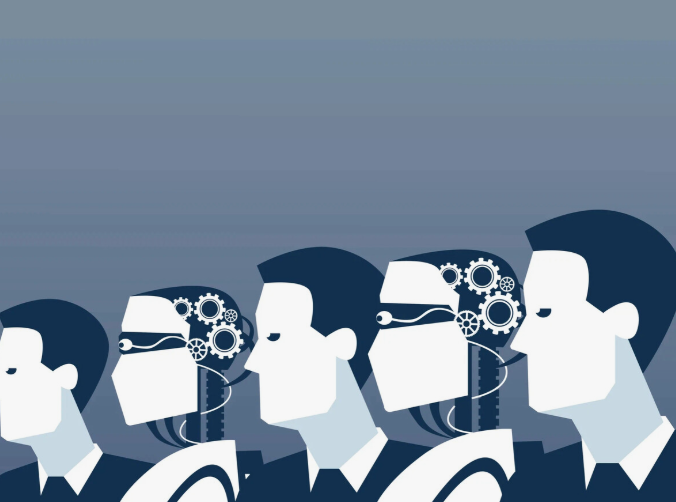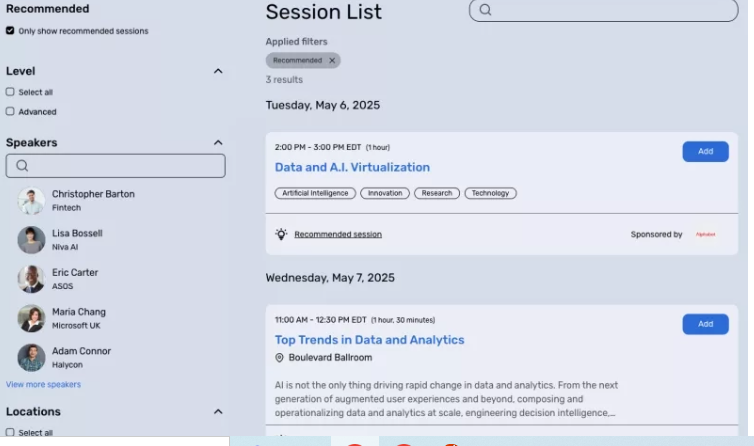blog
Top Event Marketing Trends in 2025: What’s Shaping the Future?

The face of event marketing is changing dynamically, offering tangible value for brands and their desired audiences. Traditional marketing approaches are no longer sufficient as brands compete to thrive in this AI-driven world. From hosting personalized in-person events to experimental marketing in the form of virtual events, the trends in event marketing are constantly changing, offering businesses ample opportunities to reach out to their audience more effectively.
According to a recent report, more than 59% of B2B event planners and markets believe virtual events will be a major part of their strategy in 2025.
Today, people don’t want to attend events; they want personalization, exclusivity, engagement, and convenience. Let’s say an event design agency hosts an interactive webinar session that goes beyond physical experiences. It explains the importance of hybrid networking, smart networking, AI personalization, and event gamification to keep the audience hooked. This is why more than 89% of the markets believe webinars are the best channels to generate leads.
Event marketing is not the same as it has been before. Trends are changing, with businesses adapting to more advanced approaches like AI and hybrid events to reach their intended audiences.
Today, we will discuss some of the 7 major trends expected to redefine the future of digital marketing in 2025!
Trend #1: Artificial Intelligence For Event Planning
AI is here to revolutionize every industry; event planning is no exception. In 2025, AI will be one of the major trends in event marketing, assisting brands in automating planning, audience targeting, and personalization for better audience engagement.
-
Smart Audience Targeting:
AI analyses data about past events, social media, registrations, etc. that can help identify a relevant audience. It can predict who will likely attend and optimize marketing strategies based on those predictions.
-
AI-Powered Personalization:
AI-facilitated recommendations suggest personalized event agendas, speakers, and networking opportunities based on attendee preferences.
For example:
The use of AI in an exhibition within the art gallery immerses a viewer into a more self-centered experience yet connects that individual to the exhibit even more.
- The recent advancements in Virtual reality allow people to enjoy real-time simulation views of themselves in the painting.
- Such experiences can differ greatly from what would occur in a regular exhibition, raising the overall experience quality.

The motion-making and personal participation elements within Virtual Reality transcend the static and turn things into engagement and communication. It creates a unique issue for the area event organizer to sell their exhibition difference against competitors.
-
AI in Event Ticketing and Registration
The inclusion of predictive analytics with AI allows greater data-based insight into the market conditions.
AI gives event marketing managers a reliable platform to report on market conditions, providing them with predictive capabilities. The AI studies past and current market data with customizable algorithms that software developers create to determine event pricing, pre-sale scheduling, and promotions.
- Moreover, AI-supported continuous pricing models that analyze demand and ticket inventories give real-time suggestions for automatically modifying prices to meet current market requirements.
Trend #2: Cross-Functional Collaboration
Effective marketing requires the collaboration of all teams, including sales, subject matter experts (SME), and marketing. In 2025, cross-functional collaboration is expected to accelerate, bringing departments together to create impactful and data-driven events. Certainly, one of the watch-out trends in event marketing will assist businesses in executing and measuring an event’s success.
The reason for cross-functional collaboration?
Event marketing isn’t just about promotional events; modern event marketing is about value delivery at every touchpoint. By aligning departments and stakeholders, organizations can:
- Deliver Insync Brand Experience at every touchpoint in the digital and physical worlds.
- Personalize data-enabled content to improve attendee engagement during an event.
- Build a single view to improve ROI measurement by integrating sales, marketing, and customer insights.
- Make available shared resources and expertise across teams for event operations.
- Drive innovation through diverse perspectives and collaborative problem-solving.
| “Event marketing acts as a driving force behind all organizational functions. For major events, marketing, sales, revenue operations, UX, development, and leadership teams collaborate to launch, promote, and contribute as subject matter experts, driving the event’s success”. |
Trend #3: Personalized Event Experiences
2025 is all about personalization. From Netflix offering recommendations based on our past experiences to Spotify wrapping a personalized playlist at the end of the year, personalization increases the chances of audience retention and engagement. Among various current trends in event marketing, personalization caters to audiences’ interests, behaviors, and preferences.
The event platforms would use data to generate personalized experiences for every attendee. Each attendee would get a unique personalized agenda, session recommendations, and networking opportunities, and everything would be customized for each person. Event organizers can analyze attendees’ behaviors, preferences, and demography to fine-tune their marketing efforts and create more meaningful content.
- Attendee Networking Recommendation: AI-enabled personalized networking will connect attendees with similar interest/goal profiles to derive the maximum networking benefit.
- Session recommendation: This is also closely related to personalization content that lets attendees personalize their journey through session recommendations based on their history, engagement, and other touchpoints.

Image Source: Pinterest.com
- Personalized Event Summaries: 57% of attendees want to receive summary information based on their activities. So, using your event app, give them a summary of their key moments and takeaways.
Personalization will also vary in communication before, during, and even after the event. By tailoring your communications, including e-mails, website content, and in-app notifications, you can offer even greater personalization of the attendee experience.
Trend #4: Hybrid Events: A Permanent Fixture
Hybrid events are undoubtedly one of the main trends in event marketing. Today, people are more comfortable attending an event online, but they also want to attend an in-person conference or trade show. The combination of the versatility of virtual attendance with the depth of face-to-face interactions is one way hybrid events maximize reach and impact.
In-person events allow ample networking opportunities, while virtual events obliterate geographical boundaries so speakers and audience members can be found worldwide.
For example:
The B2B Summit North America is the annual gathering of B2B marketers and sales teams to learn how to share ideas and build their businesses. A few years back, it was conducted in a hybrid mode, offering breakouts, networking, and keynotes for everyone present, whether physically or online.
It helped visitors with a guided platform orientation to familiarize them with the event and assist them in navigating it, while a virtual sponsorship marketplace supported further digital marketing engagement. It was so successful that Forrester aimed to keep the hybrid format.
That practice is being followed for virtual conferences and physical trade shows nowadays. Giving people many choices about how to attend can create huge ripples in reach and attendance.
Why Hybrid Events Work:
- Allow attendees flexibility to decide the preferred format of participation,
- Enhance reach to wider audiences at places far away,
- Combine human connection with digital convenience.
Trend #5: Gamification In Events
Certainly, one of the interesting event marketing trends will continue to rise in 2025. Gamification includes using interactive game elements of the game contexts to keep the audience engaged with the ongoing event.
For instance, you can enhance your events with quizzes, leaderboards, and other elements drawn from game design and themes.
According to a report, the global market of gamification stood at $9.1 billion in 2025, with the expectation to reach $30.7 billion by the end of 2025.
For example:
Docker is a software platform that allows developers to create and test apps across operating systems. Docker Dash, a live video game developed for a recent DockerCon edition, saw 5,000 attendees enlisted as “players” to create an app together by solving a set of interactive challenges within the game.
Gamification surely creates memorable experiences, but it is also an opportunity to showcase your product and generate buzz online. The concept is not confined to in-person events. Event marketers can use challenges, video games, and other gamification formats just as easily in digital events.
Trend #6: User-Generated Content: Let The Audience Share Their Story
2025 brings a new era of event marketing where user-generated content is becoming a crucial element for driving engagement. It’s not only about marketers’ approach; it’s more about influencing audiences and attendees to share content for better community building and authenticity. This content includes pictures, videos, testimonials, Q&A, hashtags, mentions, blogs, and more.
Brands can use UGC by deploying real-time displays or social media walls as a platform that features attendee-generated content, amplifying voices and bringing attendees even closer to the event.
How to Generate UGCs:
- Event hashtag for social media.
- Live audience polls and question answering are used to gather input.
- During the event, a real-time showcase of attendee-generated content will be held on social walls.
Trend # 7: The Green Future of Event Marketing
Sustainability in events deserves to continue for ages. In 2025, sustainability will not only be a trend but an imperative for all businesses. Creating sustainable events, however, means more than just waste reduction.

Image Source: Yandex.com
This means weighing the pros and cons of materials for the event setup, the marketing of the event, and the carbon emissions involved in travel. Moreover, Participants’ environmentally conscious attitude forces brands to take crucial steps toward reducing carbon footprints.
- In the case of virtual and hybrid events, sustainability is built into the designs, as no travel and no need for a physical venue will save a considerable share of the event’s carbon footprint.
Your events must be greener to demonstrate that you care about your customers’ concerns.
For example, The 2024 Paris Olympics flaunted its green credentials by:
- Recycling 54.6% of all waste created
- Reusing discarded electronics to make the athletes’ medals
- 40% of the spectator areas were built from wood
- Building the village plaza out of timber borrowed from local districts, then returning it afterward
- Using 2650 electric vehicles for transportation purposes
Lead The Way In Event Marketing With Tangence
Event Marketing in 2025 is about innovation, personalization, and attendee engagement. These 7 trends represent the smart future of event marketing driven by various immersive and interactive experiences. From making events more advanced with AI to promoting sustainability, it is time for brands to buckle up and embrace these trends before the competition takes over.
However, to make a diverse impact, it is always better to partner with a reliable event design agency like Tangence. With years of experience in event marketing, we know how to utilize current market trends to make your events stand out. Whether you are looking for AI personalization, a hybrid approach, or sustainable event solutions, Tangence is your top solution.
Choose Tangence and reshape the future of event marketing forever!!